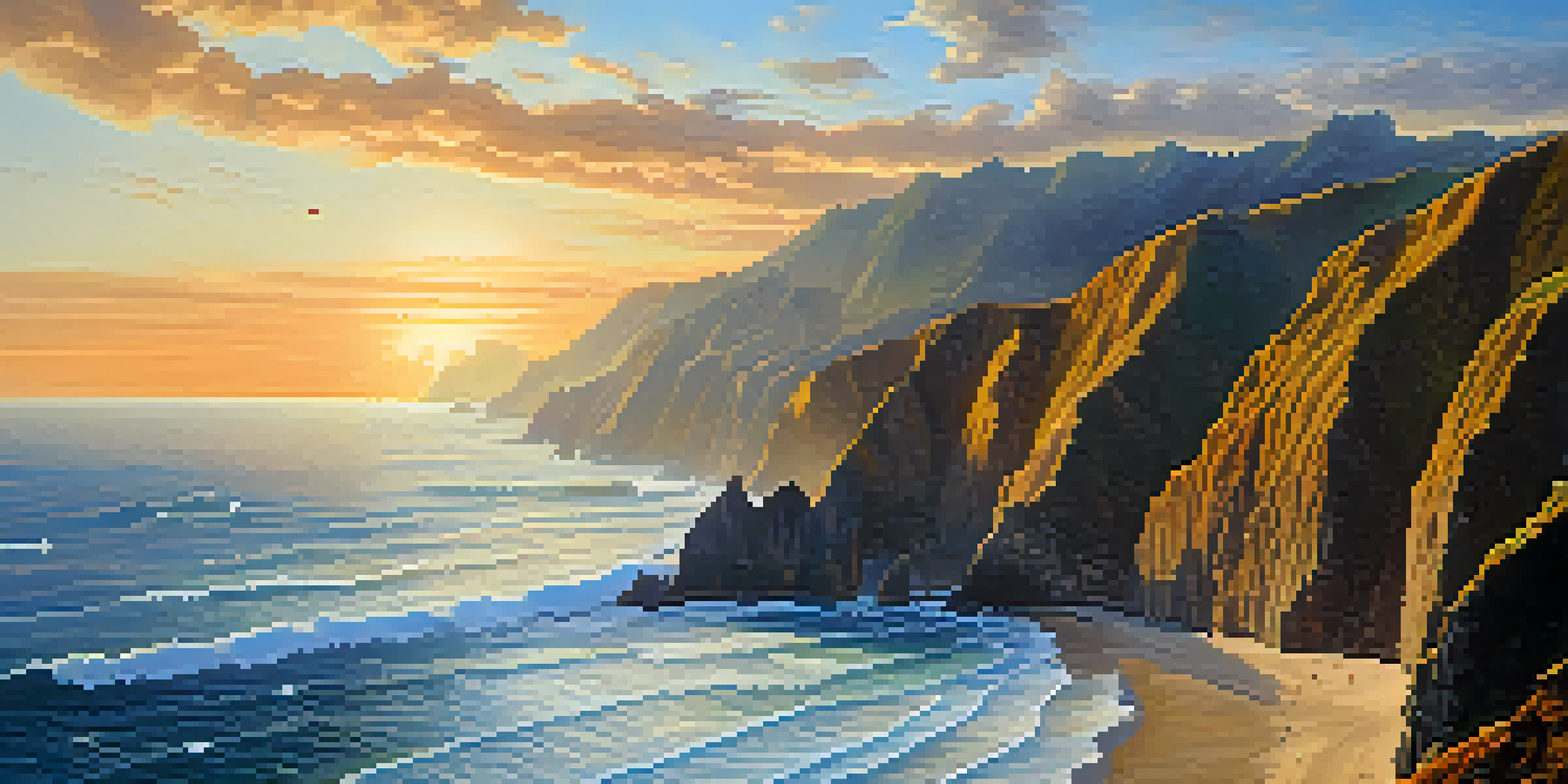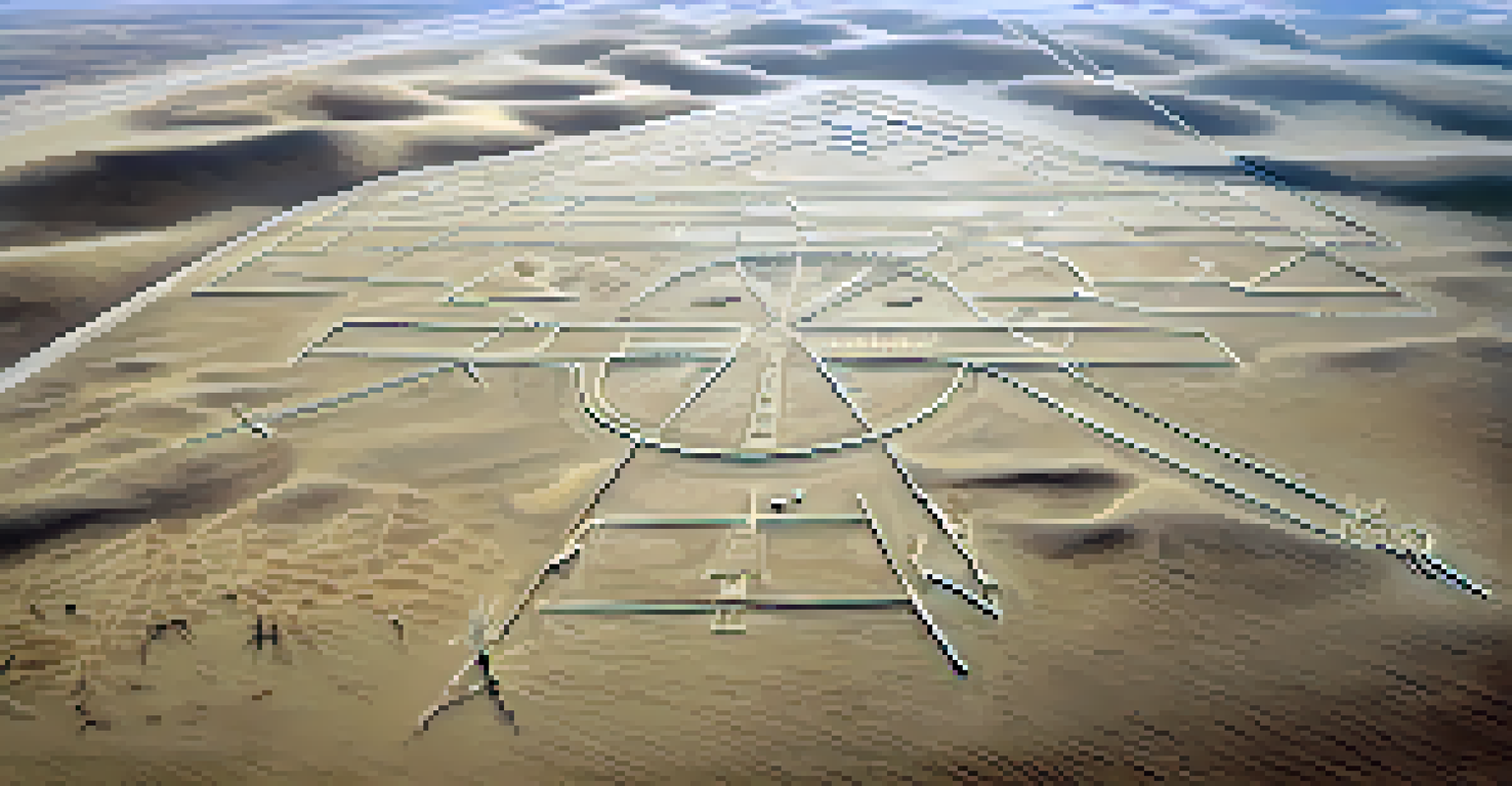The Geological Wonders of the Peruvian Coastline

Introduction to Peru's Breathtaking Coastline
The Peruvian coastline stretches over 2,400 kilometers, offering a captivating array of geological features that tell the story of the earth's history. From arid deserts to lush valleys, the coast is a geological treasure trove waiting to be explored. Understanding these wonders not only enriches our appreciation for nature but also highlights the dynamic processes that shape our planet.
The earth has music for those who listen.
Located in a tectonically active region, the Peruvian coastline is primarily influenced by the convergence of the Nazca and South American plates. This interaction creates stunning geological formations, like the Andes Mountains, which loom majestically over the coastline. The unique combination of coastal and mountainous landscapes creates a breathtaking visual experience that captivates visitors.
As we journey through this article, we'll uncover the fascinating geological wonders that make the Peruvian coastline a must-see destination. Each section will shine a light on different aspects of this region's geology, showcasing its beauty and complexity.
The Dramatic Cliffs of the Peruvian Coast
One of the most striking features of Peru's coastline is its dramatic cliffs, which rise sharply from the ocean below. These cliffs, sculpted by the relentless pounding of waves and wind, reveal layers of sedimentary rock that narrate the region's geological history. Standing atop these cliffs, you can witness the power of nature and the artistry of erosion.

The cliffs are not just visually stunning; they also provide valuable insights into the earth's past. Fossils embedded within the rock layers offer a glimpse into ancient marine life and changing climates. This geological record of evolution is crucial for scientists studying the history of our planet.
Dramatic Cliffs Showcase Geology
Peru's coastline features striking cliffs that reveal layers of sedimentary rock, providing insights into the region's geological history.
Popular spots like the Paracas National Reserve showcase these majestic cliffs, where visitors can hike, photograph, and immerse themselves in the natural beauty. The contrast of the towering cliffs against the deep blue of the Pacific Ocean creates a picturesque landscape that leaves a lasting impression.
The Enigmatic Nazca Lines: A Geological Marvel
Among the most intriguing geological wonders are the Nazca Lines, a series of enormous geoglyphs etched into the arid desert floor. Created by removing the top layer of stones, these lines form various shapes, including animals and geometric patterns. Their origins remain a mystery, captivating researchers and tourists alike.
Nature does not hurry, yet everything is accomplished.
The Nazca Lines are not only a testament to human creativity but also highlight the region's unique geology. The dry climate and stable winds have preserved these ancient designs for centuries, showcasing the interplay between nature and human ingenuity. Standing above these lines, you get a profound sense of connection to the past.
Visiting the Nazca Lines often involves a scenic flight, offering a bird's-eye view of these incredible formations. This aerial perspective enhances the experience, allowing you to appreciate the scale and precision of these ancient artworks, while also marveling at the surrounding desert landscape.
Unique Coastal Ecosystems: Where Geology Meets Biodiversity
The geological features of the Peruvian coastline are not just about rocks and formations; they also create diverse ecosystems that thrive in this unique environment. Coastal wetlands, rocky shores, and sandy beaches provide habitats for a variety of flora and fauna, making it a hotspot for biodiversity. Understanding this relationship between geology and ecology is vital for conservation efforts.
For instance, the Humboldt Current brings nutrient-rich waters to the coast, supporting a vibrant marine ecosystem. This current plays a crucial role in sustaining fish populations, which in turn support seabirds and marine mammals. The interdependence of these species highlights the importance of preserving their habitats.
Nazca Lines: A Human-Geo Connection
The Nazca Lines are enigmatic geoglyphs that highlight the interplay between human creativity and the region's unique geological features.
Exploring areas like the Ballestas Islands allows visitors to witness the beauty of this biodiversity firsthand. From sea lions basking on the rocks to colorful birds nesting in the cliffs, the coastal ecosystems are a living testament to the intricate connections formed by geological processes.
The Wonders of the Peruvian Desert: Sand Dunes and More
Peru's coastline is punctuated by vast deserts that showcase remarkable geological features, including towering sand dunes and unique rock formations. The Ica Desert, for example, is home to some of the tallest sand dunes in the world, which shift and change with the winds, creating an ever-evolving landscape. This desert environment offers a stark contrast to the lush coastal areas and mountains.
The mesmerizing patterns formed by the wind and sand serve as a reminder of nature's artistry. Adventurers can engage in activities like sandboarding or dune hiking, experiencing the thrill of navigating these natural wonders. The beauty of the desert is not just in its vastness but also in the delicate ecosystems that have adapted to survive in such arid conditions.
Visiting the Huacachina Oasis, a small village surrounded by dunes, provides a perfect opportunity to appreciate the interplay of water and sand. This oasis, with its serene lagoon, showcases how even in a desert, life can flourish, further emphasizing the diverse geological wonders of the Peruvian coastline.
The Richness of Marine Life Along the Coast
The Peruvian coastline is renowned for its rich marine life, thanks in large part to its unique geological features. The continental shelf, with its steep drop-offs and underwater canyons, creates ideal conditions for diverse marine ecosystems to thrive. This abundance of life not only enriches the local culture but also supports a vital fishing industry.
Diverse species, including the iconic Humboldt penguin and various types of whales, call these waters home. The cold, nutrient-rich waters offer plentiful food sources, attracting marine animals from far and wide. This natural bounty is a testament to the complex geological processes that shape the underwater landscape.
Biodiversity Thrives Along the Coast
The diverse ecosystems along Peru's coastline, supported by geological formations, create habitats for a rich variety of marine and terrestrial life.
For those interested in marine exploration, activities like snorkeling and diving reveal the vibrant underwater world. Whether you're swimming alongside colorful fish or observing majestic sea turtles, the coastal waters of Peru offer an unforgettable experience that showcases the wonders of marine geology.
Conservation Efforts: Protecting Peru's Geological Treasures
As we marvel at the geological wonders of the Peruvian coastline, it's crucial to consider the importance of conservation. Many of these natural formations and ecosystems face threats from human activities, climate change, and pollution. Protecting these areas is essential not just for preserving natural beauty but also for maintaining biodiversity and ecological balance.
Organizations and local communities are working tirelessly to implement conservation strategies that safeguard these geological treasures. Initiatives include sustainable tourism practices, habitat restoration projects, and educational programs aimed at raising awareness about the importance of protecting the environment. Collaboration between government and non-profit organizations is key to these efforts.

Visitors to the region can also play a role in conservation by practicing responsible tourism. Simple actions, like staying on marked trails and minimizing waste, contribute to the preservation of Peru's stunning geological features. By understanding and respecting the environment, we can all enjoy the wonders of the Peruvian coastline for generations to come.